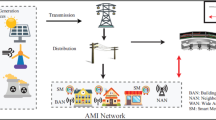Abstract
Wireless sensor networks (WSN) have turned into a main area for research. A sensor is a gadget that reacts and recognizes some kind of contribution from both physical and other environmental conditions, for example pressure, heat, light and so on. The yield of the sensor is, by and large, an electrical signal that is transmitted to a controller for processing. WSN can be chosen as per application demands. Smart grid is meant for efficient electricity transmission with low cost of electricity rates and high security. Accordingly, solar cells and wind turbines are the standard distributed renewable power generators. However, compared to the traditional energy production situation, it is difficult to predict the demand–supply drawback. Voltage fluctuations and grid instabilities are the main problems caused by low-voltage power grid. Extension of a smart grid is needed to find a path way for effective applications such as wireless energy management. In this paper, the researcher proposes a skilled monitoring system for power generation. The load-side power is kept on observation and the data sent to the monitoring unit. The connected solar panels are controlled based on the demand for current supply. The faulty solar panel is exposed by enabling web browser application with IoT. Every 2 s, data in the utility and generation units are sent to the web page for processing. In the experimental section a voltage of about 5 V and 25 V is obtained while variations from 0 to 5 V in the output voltage by the voltage sensor are seen. Dynamic power source solar panels are connected and disconnected based on the load capacity. Variations in dynamic load can be made in the grid. Power source can be varied according to the load present in the grid. The power source retained in the grid will be load capacity + 50% more to enable with standing sudden variations in the load. When variations in any load current vary close to 15% of the total capacity of the grid, another power source is added to the grid. Total power source is designed to the maximum load capacity, and dynamic power source is connected according to the load present in the grid. As per the result achieved by the data, it is proven that the proposed mechanism is far better than the existing traditional systems.





Similar content being viewed by others
References
Yao R et al (2013) Quality-driven energy-neutralized power and relay selection for smart grid wireless multimedia sensor based IEEE IoTs. IEEE Sens J 13(10):3637–3644
Sandgani MR, Sirouspour S (2018) Priority based Micro grid energy management in network environment. IEEE Trans Sustain Energy 9(2):980–990
Al-Anbagi I, Erol-Kantarci M, MouftahIEEE HT (2015) Delay critical smart grid applications and adaptive QoS provisioning. IEEE Access 3:1367–1378
Breaden C, Medley P, Watson F, Currie R, Abbey C, Mendoza I (2017) Power hardware-in-the-loop testing of a smart distribution system. In: IEEE Power and Energy Society General Meeting, pp 1–5
Ogbodo EU, Dorrell D, Abu-Mahfouz AM (2017) Cognitive radio based sensor network in smart grid: architectures, applications and communication technologies. IEEE Access 5:19084–19098
Salinas S et al (2013) Dynamic energy management for the smart grid with distributed energy resources. IEEE Trans Smart Grid 4(4):2139–2151
Baroudi U (2017) Robot assisted Maintenance of wireless sensor networks using wireless energy transfer. IEEE Sens J 17(14):4661–4671
Karthipan R, Vishvaksenan KS, Kalidoss R, Sureshbabu R (2016) Uplink capacity enhancement in IEEE 802.22 using modified duplex approach. Wirel Pers Commun 86(2):635–656
Rajakani K, Bhagyaveni MA (2012) Adaptive duplex technique for reduction of turnaround time in IEEE 802.22. In: Krishna PV, Babu MR, Ariwa E (eds) Global Trends in Computing and Communication Systems, ObCom 2011. Communications in Computer and Information Science, vol 269. Springer, Berlin, Heidelberg
Damodaran SP, Srinivasan VK, Rajakani K (2018) Optimized and low-complexity power allocation and beamforming with full duplex in massive MIMO and small-cell networks. J Supercomput. https://doi.org/10.1007/s11227-018-2400-z
Vishvaksenan KS, Mithra K, Kalidoss R, Karthipan R (2016) Experimental study on Elliot wave theory for handoff prediction. Fluct Noise Lett 15(4):1–11
Saravanan M, Kalidoss R, Partibane B, Karthipan R (2017) Mitigation of mutual exclusion problem in 5G new radio standards by token and non token based algorithms. Clust comput. https://doi.org/10.1007/s10586-017-1387-1
Kalidoss R, Saravanan M, Manikannan K (2018) Analytic hierarchy processes for spectrum sharing in 5G new radio standard. Wirel Pers Commun. https://doi.org/10.1007/s11277-018-5467-1
Author information
Authors and Affiliations
Corresponding author
Rights and permissions
About this article
Cite this article
Amarnath, D., Sujatha, S. Internet-of-Things-aided energy management in smart grid environment. J Supercomput 76, 2302–2314 (2020). https://doi.org/10.1007/s11227-018-2492-5
Published:
Issue Date:
DOI: https://doi.org/10.1007/s11227-018-2492-5




